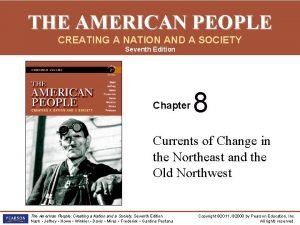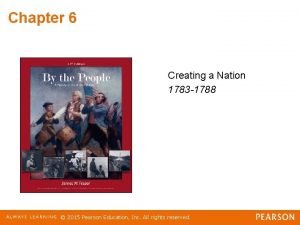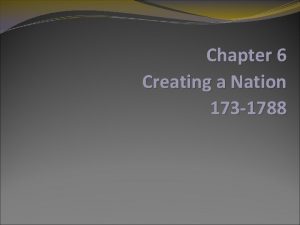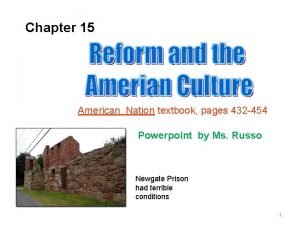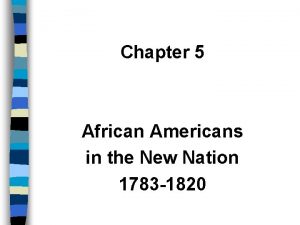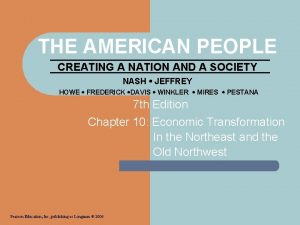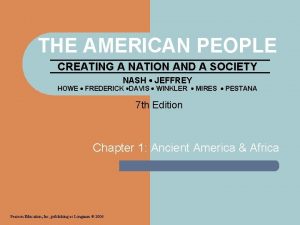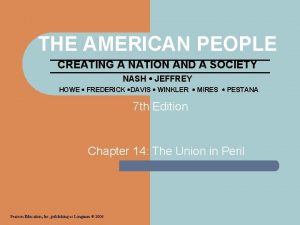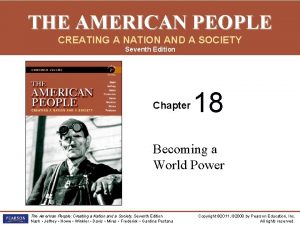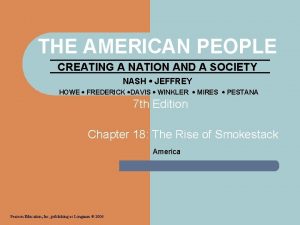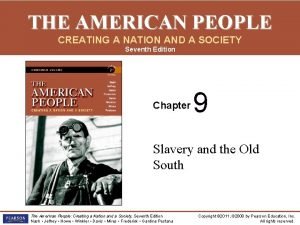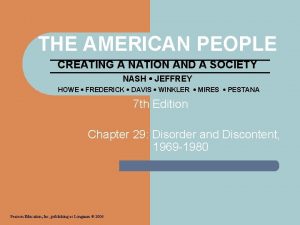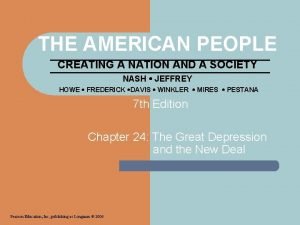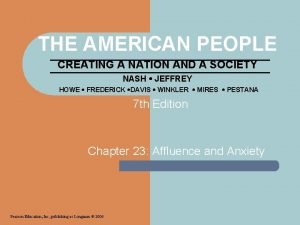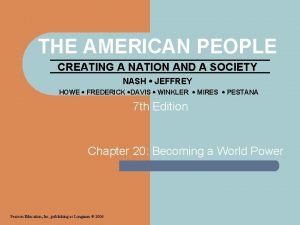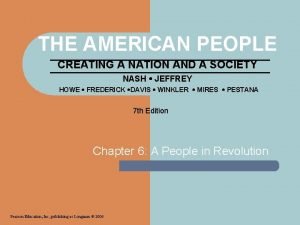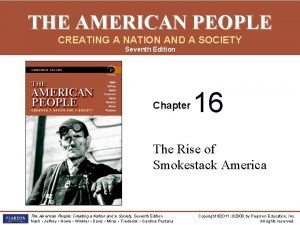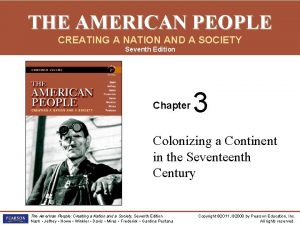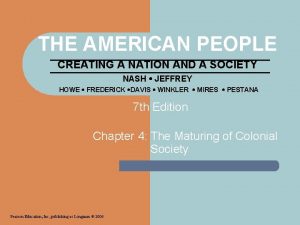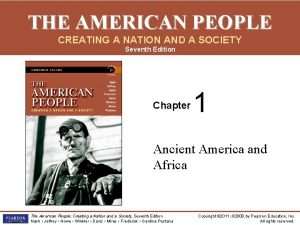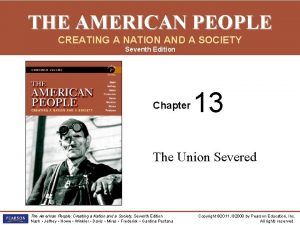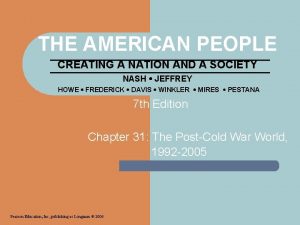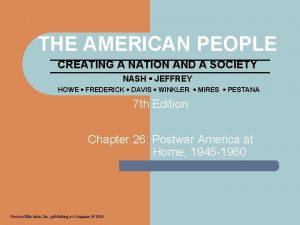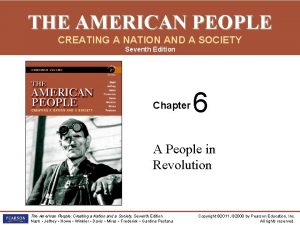THE AMERICAN PEOPLE CREATING A NATION AND A









































- Slides: 41

THE AMERICAN PEOPLE CREATING A NATION AND A SOCIETY NASH JEFFREY HOWE FREDERICK DAVIS WINKLER MIRES PESTANA 7 th Edition Chapter 12: Shaping America in the Antebellum Age Pearson Education, Inc, publishing as Longman © 2006

RELIGIOUS REVIVAL AND REFORM PHILOSOPHY l l Religious rebirth gave some Americans a mooring in a fast-changing world Others were inspired to refashion their society – – Worked through new political parties to shape an agenda through the nation Worked through reform associations targeting a particular social evil

FINNEY AND THE SECOND GREAT AWAKENING l From the late 1790 s to the late 1830 s, a wave of religious revivalism swept through the United States – l Revival took new emphasis with the 1830 arrival of Charles Finney who shifted revivalism frontier camps to upstate New York (especially Rochester) and the Old Northwest – – l l l British religion was becoming more conservative while American religion was becoming more democratic Areas had been hit by social and economic changes Wave of religious enthusiasm led to tremendous growth of Methodists, Baptists and other evangelical denominations Revivalists toned down the Calvinist rhetoric and emphasized emotion over doctrine Even Catholics caught the revivalist fever Finney’s revivals, unlike Catholic and southern ones, insisted that conversion was not the end of the experience but the beginning


THE TRANSCENDENTALISTS l Transcendentalists were a small but influential group of New England intellectuals who lived around Ralph Waldo Emerson, the era’s foremost thinker – – – l l l Name came from their belief that truth was found in intuition beyond the senses Urged people to look inward and to nature for self-knowledge, selfreliance, and the spark of divinity burning within They questioned slavery, the pursuit of wealth, and the restrictive conformity of social life Margaret Fuller wrote about women’s rights, literature, prison reform and the moral quality of everyday life Nathanial Hawthorne and Herman Melville, while not transcendentalists, were concerned with similar issues and celebrated virtue over self-interest and emotion over reason Henry David Thoreau believed in the virtues of a natural life and the importance of protesting unjust laws

THE POLITICAL RESPONSE TO CHANGE l l About 40% of Americans were touched by evangelical Protestantism which, in turn, effected their views of politics Concern for continued health of democratic republican experiment main issue – – New emphasis on voting as franchise extended to include all white men Panic of 1819 and Andrew Jackson’s campaign led to widespread interest in politics

CHANGING POLITICAL CULTURE l l Andrew Jackson’s presidency was instrumental in bringing politics to the center focus of many American lives Jackson promised a more democratic system of politics yet was personally not democratic – – – l Four times as many voters turned out in 1828 than in 1824 to vote for Jackson supported slavery and forcibly removed southern Indians to the west During his administration the rich got richer while the poor struggled His administration did see the effectual emergence of a competitive party system that involved conventions, rallies and parades to encourage voter participation and party identification – – Appealed to popular emotions, religious views and ethnic prejudices Language became contentious and militaristic

JACKSON’S PATH TO THE WHITE HOUSE l l Born poor and poorly educated, Jackson became a successful frontier lawyer, state attorney general and a substantial landowner. Reputation was gained from military exploits Having won both the popular and electoral votes in the 1824 election, Jackson lost the presidency to John Quincy Adams when it went to the House of Representatives as no candidate had a majority Jackson organized a political coalition, Democratic party, had the backing of John C. Calhoun, used newspapers to his advantage and tactfully waffled on major issues – – l l The Adams-Clay coalition called themselves the National Republicans. Both sides made slanderous personal attacks 1828 “Tariff of Abominations” was designed to win Jackson support in key states by protecting New England textiles, Pennsylvania iron and some agricultural products Jackson won the election with 56% of the vote


OLD HICKORY’S VIGOROUS PRESIDENCY l Jackson’s presidency was guided by a belief in the limited power of the national government and the obligation of the government to defend the nation’s average people against the tyranny of the wealthy – – – Aggressively used presidential veto against bills that conflicted with his political agenda Favored a rotational system of staffing the government (though more rhetoric than action) Opposed internal improvements he saw as infringing on states’ rights

OLD HICKORY’S VIGOROUS PRESIDENCY l Tariff was particularly controversial since northern states favored as protection for their industries while southern states felt it made their purchased goods more expensive and might be a prelude to federal interference with slavery – – l Vice President Calhoun pressed nullification as means for southern states to protect themselves Daniel Webster and Andrew Jackson believed states had no right to nullify national laws When South Carolina nullified the 1832 tariff (and the 1828 tariff) and threatened to secede, Jackson insisted they abide by federal law – – Congress passed the Force Bill and modified the tariff South Carolina repealed the nullification of the tariff and nullified the Force Bill

JACKSON’S NATIVE AMERICAN POLICY l Andrew Jackson favored forcible removal of Native Americans and relocation westward on reservations – l A Supreme Court decision in 1823 stating that Indians could occupy but not hold title to land in the United States made Jackson’s policy easy to implement – l Many of the Five Civilized Tribes of the Southeast (Cherokees, Choctaws, Chickasaws, Creeks and Seminoles) lost land in the early 19 th century Native Americans responded by restricting land sales to government agents and assimilating certain aspects of white culture Jackson claimed that humanity and states’ rights justified removing the Indians

JACKSON’S NATIVE AMERICAN POLICY l l In 1829 Georgia claimed jurisdiction over the Cherokees and their lands In 1830 the Cherokees brought their complaints to the Supreme Court – – l Despite Supreme Court ruling that Georgia law did not apply, by 1835 Jackson informed the Cherokees they had to move – – l 1831: Cherokee Nation v. Georgia 1832: Worcester v. Georgia 1837 and 1838 U. S. Army removed the Cherokee to Oklahoma Removal cost $6 million (deducted from $9 million paid Cherokee) and cost one quarter of Cherokees their lives Between 1821 and 1840, all southeastern tribes and those in the Old Northwest were forced westward

Native American Removals: Southeast and Midwest


JACKSON’S BANK WAR AND “VAN RUIN’S” DEPRESSION l The Second Bank of the United States had been given a twenty year charter in 1816 and had been under the control of Nicholas Biddle since 1823 – – l l A responsible organization, the Bank restrained smaller state banks from making unwise loans by insisting they back their notes with specie (gold or silver) and by calling in its own loans Accepted federal deposits, made commercial loans and bought and sold government bonds While some supported the bank, while a many others, including Jackson, found a variety of reasons to distrust it and dislike its policies When Biddle asked to renew his charter four years early in 1832, Jackson vetoed the bill and used the struggle to underscore differences between social classes

JACKSON’S BANK WAR AND “VAN RUIN’S” DEPRESSION l The bank furor clarified party differences – – – l Whigs (former National Republicans) nominated Henry Clay in 1832 Anti-Masons expressed resentments against the elitist Masonic order Jackson won easily Jackson transferred government funds from B. U. S. to state banks leading to a wave of speculation in western lands and new internal improvement schemes which inflated land prices – – Jackson sought to curtail speculation by insisting that only specie be accepted for land payments (Specie Circular 1836) The result was the Panic of 1837 (which was probably more closely related to trade problems with Britain and China) which became a problem for Jackson’s successor Martin Van Buren


JACKSON’S BANK WAR AND “VAN RUIN’S” DEPRESSION Panic of 1837 l $ 6 million was lost on defaulted debts l By fall of 1837 one-third of America’s workers were unemployed and thousands had only part-time work l Those with jobs saw their wages fall 30 -50% within two years l The price of necessities nearly doubled l Soup kitchens and bread lines grew l Destroyed the trade union movement and violence increased as the depression grew worse

THE SECOND AMERICAN PARTY SYSTEM l Democrats: had a sounder claim of representation of the common man with a broad base of support across the nation – – l Whigs: represented majority of wealth and were strongest in New England areas settled by New Englanders – – – l Espoused liberty and local rule Appealed to persecuted religious minorities Endorsed American System Many large Southern planters joined due to position on bank credit and internal improvement Religious and moral values often shaped policy and supported a wide variety of reforms 1840: Whigs nominated William Henry Harrison and John Tyler (VP) while Democrats nominated Van Buren – Harrison won but died less than a month after taking office, leaving Tyler in charge

PERFECTIONIST REFORM AND UTOPIANISM l l Mid-nineteenth century reformers sought to create a perfect world Impulse to reform was rooted in: – – – – Puritan idea of American mission Secular examples of founding fathers Republican ideology Romantic beliefs in the natural goodness of human nature. Social activist tendencies in Whig ideology Anxiety over shifting class relationships and socioeconomic change Family influence and the desire of young people to choose careers of principled service Direct influence of revivalism


THE INTERNATIONAL CHARACTER OF REFORM l Atlantic Ocean was a highway for reform as many of the issues confronting the United States was also being experienced by Europeans – – American abolitionists traveled to England English abolitionists visited the United States Scottish cotton mill owner Robert Owen came to U. S. to establish a socialist community, inspiring a variety of cooperative efforts

THE DILEMMAS OF REFORM l Was it more effective to change people’s minds in order to change bad institutions or to change bad institutions assuming that will cause people’s behavior to change? – – l l l First path relies on education and moral suasion. Second path lead to political and institutional activism Should they seek limited, piecemeal change or wholesale, utopian change? Should they use violence or make alliances with questionable allies or maintain their values at all costs? Reformers tended to quarrel with one another

UTOPIAN COMMUNITIES: Oneida and the Shakers l l Many reformers of the age sought to create the perfect representation in miniature of what life should be John Humphrey Noyles founded a society of “free love” and socialism at Oneida, New York – – l Included communal child rearing, sexual equality in work, removal of competitive spirit, elaborate program of mutual criticism Invested in modern manufacturing and prospered economically The Shakers, founded by Mother Ann Lee, believed in communal property, perfectionism, and celibacy. – Shaker worship featured a wild dance intended to release sin from the body


OTHER UTOPIAS l Over 100 communities like the Shakers and Oneida were founded during the era but most were small and all collapsed in a short time. – – – l Secular communities sought to address social misery by crating better environments – – l The Ephrata colony of Pennsylvania The Harmonists of Indiana The Amana Society in Iowa Robert Owen’s New Harmony lasted three years Brook Farm lasted less than three years though members produced some memorable literature Failure resulted from the fact that most Americans were unwilling to share either their property or their spouses – Also suffered unstable leadership, financial bickering, local hostility, indiscriminate admission of members, and waning enthusiasm

MILLERITES AND MORMONS l William Miller declared that the Second Coming of Christ was slated for March 1843 – – l When nothing happened in 1843, he moved the date and died discredited in 1848 Millerite sect, Seventh-Day Adventists, decided that Christ was coming soon Joseph Smith clamed to be visited by the angel Moroni who led him to the Book of Mormon which predicted an American prophet who would form a new kingdom of Christ in the United States – – Founded Church of Latter Day Saints in 1830 and attracted thousands of followers Migrated to Ohio, then Missouri then Illinois due to ridicule, persecution and violence Mormons prospered though Smith was killed by irate neighbors after he ran for the presidency in 1844 Leadership passed to Brigham Young who moved the Mormons westward

REFORMING SOCIETY l Reformers created and joined all sorts of social reform societies whose ranks were swelled by thousands of women, stirred to action by religious revivals and freed from domestic burdens by delayed marriage and smaller families

TEMPERANCE l l l Nineteenth century Americans drank to excess Early efforts at curbing the public’s consumption focused on moderation The American Temperance Society (1826) was dedicated to total abstinence – – – l The Society successfully used revival techniques of the Second Great Awakening to motivate “converts” In 1840, differences in goals fractured the temperance movement into a variety of separate organizations Many laboring people joined during hard times The Washington Temperance Society (1840) saw drink as a disease and focused on political action – – Others followed political emphasis in 1840 s, lobbying for political option laws Per capita drinking fell dramatically in the 1850 s

HEALTH AND SEXUALITY l Reformers also attacked too much eating, stimulants and sex – l l Endorsed diet and exercise programs and even cure-all panaceas Sylvester Graham focused on sexual purity Antebellum “health” manuals advocated abstinence and warned of dangers of “wasting” semen

HUMANIZING THE ASYLUM l l l Some efforts of reform were not aimed at the salvation of the individual but towards organizations such as hospitals or asylums Horace Mann led the struggle for common schools in Massachusetts Beginning in the early nineteenth century, states built institutions to uplift and house social outcasts Dorothea Dix championed the cause of the mentally ill, believing adequate facilities and proper living conditions would go far to produce some sort of a “cure” Despite attention paid to building the right type of prisons and other institutions to encourage reform, little really changed

WORKING-CLASS REFORM l In America, the institution most in need of reform was the factory – – l Jacksonian Democrats siphoned votes from workingmen’s parties while unions advocated practical goals like shorter hours, improved wages, and prevention of the threat from cheap labor – l Workingmen’s parties—advocating free, tax-supported schools; free public lands in the West; and elimination of monopolistic privilege— formed to address these issues Trade union activity began in 1827 and by 1834 the National Trades Union was founded Shared a number of issues with middle class supporters Workers struck 168 times between 1834 and 1836, mostly over wages – – In 1835 struck for 10 -hour day. Panic of 1837 undermined the movement

ABOLITIONISM AND WOMEN’S RIGHTS l Arthur and Lewis Tappan financed the Lane Seminary to train abolitionist leaders – “Rebels” from the institution fled to Oberlin and created the first institution open to women and blacks

TENSIONS WITHIN THE ANTISLAVERY MOVEMENT l 1 January 1831, William Lloyd Garrison published the antislavery journal The Liberator – l l Established first the New England Anti-Slavery Society (1833) then the American Anti-Slavery Society which called for an immediate end to slavery rather than gradual emancipation The American Colonization Society (1816) sought to send blacks back to Africa Determination to eliminate slavery was reinforced by victories elsewhere in the world – – – Agitation against the international slave trade in several European countries Abolition of slavery in Latin American countries in 1820 s and 1830 s. By 1833, British activists had achieved freedom for British Caribbean slaves

TENSIONS WITHIN THE ANTISLAVERY MOVEMENT l Activists disagreed about tactics as well as goals – – – l l Primary method was to convince slaveholders that slavery was a sin Others preferred more direct political and economic measures More rarely some called for slave rebellions In 1840 the American Anti-Slavery Society split, one group staying with Garrison and his advocacy of women’s participation and the other left to pursue political action and the Liberty party. Abolitionists were further divided by race and class – – – Some black nationalists rejected white society and advocated emigration to Africa, though most sided with Frederick Douglass and worked to end slavery in U. S. Some blacks led vigilance groups that helped slaves escape to Canada or safe northern communities National Negro Convention movement (1830) not only discussed slavery but also discrimination facing northern blacks

FLOOD TIDE OF ABOLITIONISM l Overall, black and white abolitionists worked well together at both ending slavery and at addressing discrimination – l l Both had to defend themselves against attacks by mobs Antiabolitionists were as fervent as abolitionists By the 1840 s the antislavery movement had gained significant strength and many who many not have supported goals were upset by mob violence and attacks on free speech – Many became convinced of the pernicious influence of the slave power

WOMEN REFORMERS AND WOMEN’S RIGHTS l l Religiously motivated women not only joined various reform causes but struggled for their rights as women, including the right to speak in public To achieve greater personal autonomy, antebellum women pursued several paths – – l Working class women went on strike Some middle class women saw the home as the center of women’s power and authority Some used their role as moral guardians to attack the double standard Some upper middle-class women denied the attractions of female domesticity all together and sought more legally protected rights Inspired by their treatment at an anti-slavery movement in England, Elizabeth Cady Stanton and Lucretia Mott held a convention at Seneca Falls in 1848 to demand equal rights for women


DISCOVERING U. S. HISTORY ONLINE Women in America http: //xroads. virginia. edu/~HYPER/DETOC/FEM/home. htm l Godey’s Lady’s Book Online Home Page http: //www. history. rochester. edu/godeys/ l Influence of Prominent Abolitionists http: //www. loc. gov/exhibits/african/afam 006. html l Transcendentalists http: //www. transcendentalists. com/ l Religion and National Culture in the Nineteenth Century http: //www. nhc. rtp. nc. us: 8080/tserve/nineteen. htm l

DISCOVERING U. S. HISTORY ONLINE Andrew Jackson http: //www. ipl. org/div/potus/ajackson. html l The Trail of Tears http: //www. ourgeorgiahistory. com/indians/chero kee/trail_of_tears. html l Social History of the Antebellum Period http: //moa. cit. cornell. edu/moa/index. html l Reform Movements http: //womhist. binghamton. edu/ l
 The american people creating a nation and a society
The american people creating a nation and a society Creating a new nation
Creating a new nation Chapter 6 creating a nation
Chapter 6 creating a nation Chapter 6 creating a nation
Chapter 6 creating a nation Nation state vs nation
Nation state vs nation State vs nation
State vs nation Nation state vs nation
Nation state vs nation The american nation textbook answers
The american nation textbook answers Holt american nation
Holt american nation Chapter 5 african american in the new nation
Chapter 5 african american in the new nation American nation chapter 4
American nation chapter 4 American nation chapter 4
American nation chapter 4 People nation tattoos
People nation tattoos Indian posse colors
Indian posse colors Surenos rules
Surenos rules Example
Example Where is the love 2016 lyrics
Where is the love 2016 lyrics Describing visual data
Describing visual data Hát kết hợp bộ gõ cơ thể
Hát kết hợp bộ gõ cơ thể Bổ thể
Bổ thể Tỉ lệ cơ thể trẻ em
Tỉ lệ cơ thể trẻ em Voi kéo gỗ như thế nào
Voi kéo gỗ như thế nào Thang điểm glasgow
Thang điểm glasgow Hát lên người ơi
Hát lên người ơi Môn thể thao bắt đầu bằng từ đua
Môn thể thao bắt đầu bằng từ đua Thế nào là hệ số cao nhất
Thế nào là hệ số cao nhất Các châu lục và đại dương trên thế giới
Các châu lục và đại dương trên thế giới Công thức tiính động năng
Công thức tiính động năng Trời xanh đây là của chúng ta thể thơ
Trời xanh đây là của chúng ta thể thơ Mật thư tọa độ 5x5
Mật thư tọa độ 5x5 Phép trừ bù
Phép trừ bù độ dài liên kết
độ dài liên kết Các châu lục và đại dương trên thế giới
Các châu lục và đại dương trên thế giới Thể thơ truyền thống
Thể thơ truyền thống Quá trình desamine hóa có thể tạo ra
Quá trình desamine hóa có thể tạo ra Một số thể thơ truyền thống
Một số thể thơ truyền thống Cái miệng nó xinh thế
Cái miệng nó xinh thế Vẽ hình chiếu vuông góc của vật thể sau
Vẽ hình chiếu vuông góc của vật thể sau Nguyên nhân của sự mỏi cơ sinh 8
Nguyên nhân của sự mỏi cơ sinh 8 đặc điểm cơ thể của người tối cổ
đặc điểm cơ thể của người tối cổ V cc cc
V cc cc
